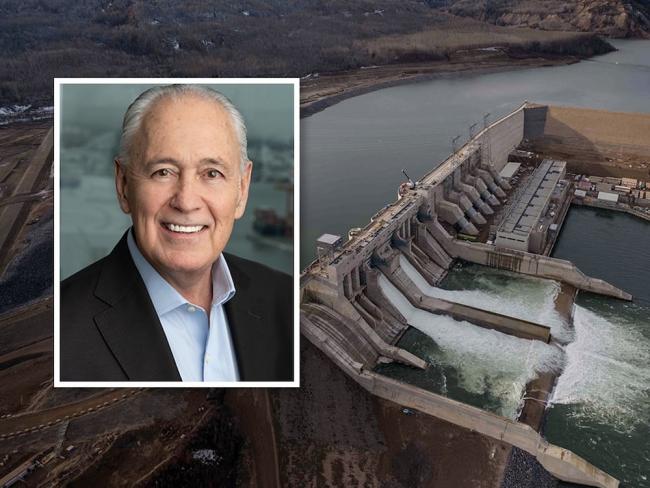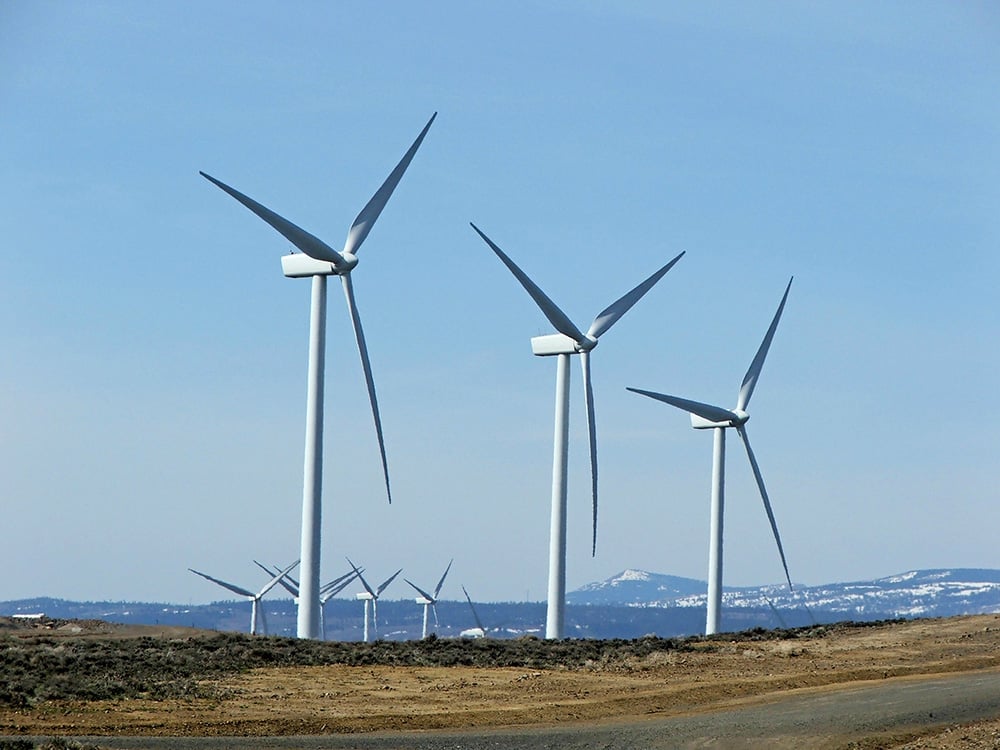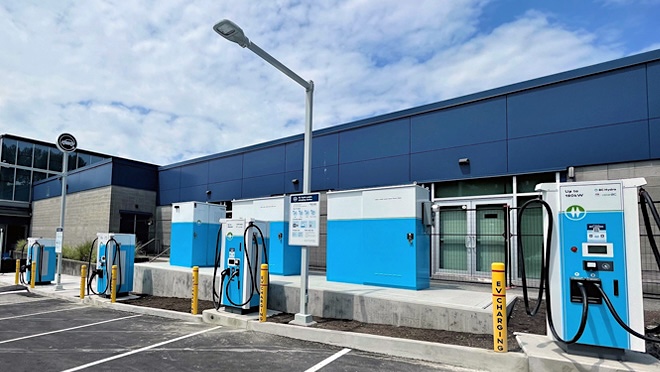Articles Menu

Nov. 25, 2025
Even as it focuses on greenlighting new wind power projects, British Columbia could eventually return to building massive hydro dams if electricity use spikes in the coming decades, according to BC Hydro chair and former B.C. premier Glen Clark.
Right now, B.C. is banking on wind to supply its residents and businesses with the electricity they will need in decades to come. Clark told The Tyee he hopes energy efficiency improvements will obviate the need for any new massive dams in the province.
But in a wide-ranging interview, Clark added a caveat: if electricity demand does significantly rise in the coming decades, the province could end up revisiting the potential for more dams — including the long-shelved Site E proposal along the Peace River.
By 2035, BC Hydro expects the province will need between 2,200 and 9,700 gigawatt hours of additional electricity each year. For comparison, B.C.’s Site C dam can produce just over 5,000 gigawatt hours. Meeting that demand will be a challenge, but Clark said it can be accomplished by greenlighting new wind projects.
Despite the limitations of wind in B.C. — the province’s gustiest areas are in its relatively flat far north — BC Hydro believes it should be able to source enough wind energy to power homes, electric vehicles and intensive industrial projects. Although solar energy isn’t completely off the table, Clark said its utility is limited both by B.C.’s relative lack of sunshine and by the fact that the province’s energy needs are particularly acute during a handful of particularly cold winter weeks.
Some environmentalists are more pessimistic about the province’s energy future and have called on BC Hydro to increase its output even faster to anticipate growing demand. They point to the prospect of mass electrification as the province turns away from gas vehicles and residential heating to electric vehicles and heat pumps. They also note that climate change will lead to smaller snowpacks, falling reservoir levels and lower hydroelectric output. Industry development — including electrified LNG facilities and computer data centres linked to artificial intelligence advances — could also cause demand to spike.
Clark, however, said BC Hydro can increase output relatively quickly if it needs to do so. Some of B.C.’s demand pressures, he said, have been mitigated by efficient light bulbs, other technological measures and closures in B.C.’s struggling forest sector.
If demand does increase dramatically long-term, Clark said B.C. could find itself revisiting megaprojects, including the long-shelved Site E dam, upriver from Site C.
Tyee senior editor Tyler Olsen recently spoke to Clark about the future of BC Hydro, the role of solar in the province’s energy future, addressing obligations and debts to First Nations, and the Crown corporation’s independence — or lack thereof — from the provincial government.
This interview has been condensed for length and clarity.
The Tyee: BC Hydro says it needs to increase electricity generation by about 5,000 gigawatt hours a year by 2034. That’s as much generating capacity as Site C, and it seems like a short timeline. Why should people feel confident that it can actually accomplish that goal?
Glen Clark: We’ve already done a request for private power from IPPs [independent power producers] and we’ve approved 10 of them to move forward to the next phase. Of the 10, they are mostly joint ventures with First Nations and they’re mostly wind power projects. Wind is a nice complement to BC Hydro. The challenge with wind is it only blows 30 per cent of the time. British Columbia’s wind power is somewhat limited. It’s not what I would call world-class. It’s good, but it’s not spectacular.
The wind blows roughly 30 per cent of the time, and that makes it an interruptible supply. So you can’t run just on wind power. You need to have something backing it up. And because the reservoirs are effectively water batteries, hydro is a nice complement to wind power, because we can let the batteries rise. So we’re in very good shape. Of those 10 projects, right now, they’re all on track.

The uniqueness of hydro is you can generate a lot of power in a short period of time as you draw the reservoirs down faster. In British Columbia, historically and still today, there’s two to four weeks a year where we use a lot more power than the rest of the time combined. It’s the winter. So you need a lot of power for a short period of time. It’s a challenge for any electricity system, is to have power available whenever people need it.
The next big innovation — and you see this in California and Arizona — is batteries. Batteries can also provide the ability to store that power, and that would improve the flexibility of the hydro system. Large-scale batteries will be deployed in British Columbia, and that’s in our plan. But at the moment, they’re not perfect because they only hold power ready for four hours. They’re improving rapidly, so they’ll get there, but at the moment, for British Columbia, it’s helpful, but not perfect.
Is that why solar is less of a solution too, because that demand comes in winter?
There are two problems with solar in British Columbia. They showed me a map here at Hydro showing solar availability, so sunlight. This is the only grey part of North America. So we have the least amount of sun of most places. Now you can produce solar even in Germany. You can produce it here too, but it’s expensive, and this is the kind of double-edged sword in British Columbia. The challenge we have is we have amongst the lowest electricity rates in the world. So every new addition, even wind power — which is relatively low-cost with all the subsidies — anything we do that’s new adds to your hydroelectricity bill, because the embedded historic costs are so dramatically lower than the marginal new costs every time we add something. This is a challenge.
This is part of the [problem] I have with some environmentalists.
They say, “Well, gee, B.C. or Canada’s behind the curve on solar power. Look at China.” Well, the reality in British Columbia is that our electricity rates are so low that solar has a hard time competing. Solar cannot compete in British Columbia if we want to retain the low rates we have.
If we had double the electricity rates in British Columbia, like they do in some parts of the U.S., then solar would be very competitive at the margin for new power. But it’s not — not because we don’t want solar; we’d love to have more solar power. It’s because of two things. One is we don’t have enough power and it’s generated the wrong time of year. Batteries aren’t long enough to bridge the gap between sunlight and daylight at night. But more importantly, the cost of solar is higher than alternatives and higher than our current costs.
But the cost is coming down so much. You look at some of these charts...
It is coming down a lot, I agree. I don’t know if you know this, but we’re buying a lot of solar power from California and Arizona because what happens is they get so much sunlight that they end up having surplus power because they have a huge expansion of solar with batteries. So we’ve been buying power almost free from Arizona, and then selling it back to them at night, when it’s really expensive. So we make quite a bit of money on that trade. That’s going to change. We’re not going to be able to make that much money because batteries are getting better, and they have more batteries, and that’ll take the place of us being able to provide them power at night. But in the short run, we make a lot of money on it. But you’re right, the good news, it’s all coming down fast, so hopefully we’ll be able to have more solar here.
In previous decades, when BC Hydro was able to meet the demands of a growing population and economy, we were in a different environment, where modern-day policies and relationships with First Nations and other communities weren’t the way they are now. Is it possible to meet those demands now while still having a positive, or at least not a negative, impact on First Nations and communities?
I really believe it is. The secret, of course, is these joint ventures, because the First Nations are buying into them. You need support from First Nations in those territories where there is wind power. Those are sparsely populated with big First Nations populations. Most of our wind power is going to come from those areas and the First Nations are going to own at least half of it.
I don’t think we have to worry too much — at least for the next decade or so, we’ve got lots of opportunities for growth.

Does that change depending on what’s creating the demand? In the north, especially, it’s the demand not of residents, but of mines and other resource operations, where First Nations might support the electricity generation, but they don’t necessarily support the industrial development.
It does change. I think it’s important to understand that there are some big macro trends. The invention of LED lighting had a huge impact on the demand curve, flattening it out. The decline in the forest industry has had a huge impact on demand in British Columbia, and, frankly, potential further decline in pulp mills and things. Those are big consumers. The last 20 years have seen a moderation of demand. There’s been some increase in demand by population growth and EVs and other things, but it’s been mitigated by the decline of the forest industry and scientific innovation.
One of the reasons that BC Hydro is supported is because when you turn your light on, it works. We have an obligation to service the people of British Columbia.
But we can’t predict the future. We have to predict the future, but we can’t actually predict it. So we have to find plans that are robust, that allow us to look at a lot of options that we can kind of ramp up quickly or slow down, depending on what’s happening with the market. The North Coast Transmission Line is a very expensive and big expansion of the system, and the wind power that we just talked about is mostly needed for that line. If the demand does not materialize on that line, then the good news is we have the ability to export power quite readily to the U.S.
We are building before demand and we haven’t done that for a long time in BC Hydro. But that’s the argument I would make for a Crown corporation. This is nation building. This is about building for the future. We are building this line in anticipation of demand that we believe is going to happen. Some of it, for sure, is going to happen.
[Note: Clark pointed to Hydro’s recent Integrated Resource Plan, or IRP, and scenarios that predict different demand futures. BC Hydro is working toward a scenario higher than the forecast it determines to be most likely. The utility isn’t, however, planning for a scenario based on the maximum potential industrial development in the province’s north.]
Why is BC Hydro not planning for the North Coast load variability scenario — the high, high demand scenario?
Because every time we build, as I said, we’re going to increase your electricity rates in Vancouver. So we have to try to support the nation-building notion without overbuilding, if we can help it. We need to be prudent about that. These [industrial projects] have such long lead times — and Hydro does too, which is obviously challenging to stay flexible. But some of the projects, like the wind projects, do have a big advantage, and that is they’re quick to turn around. So, by the way, is a natural-gas-fired plant, which we’re not planning on, but they’re more like a two-year turnaround, as opposed to a dam that might be 15 years.
So it’s not crazy hard to ramp up if we have to. And these IRPs are more like iterative plans. They’re not cast in stone. So this is our best forecast based on all the evidence, but every year we have to update that based on what we’re seeing. And we can dial some of it back, and we can ramp some of it up, depending on how it goes.
[Top photo: BC Hydro chair Glen Clark says wind power and technological advances should fulfil BC’s short-term power needs, but more megaprojects like Site C, pictured, aren’t off the table if demand increases substantially in coming decades. Photos of Clark and Site C via BC Hydro.]